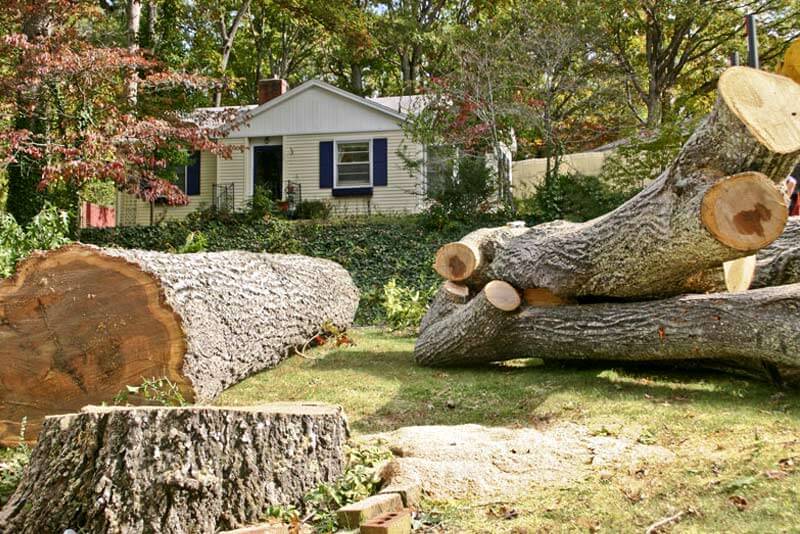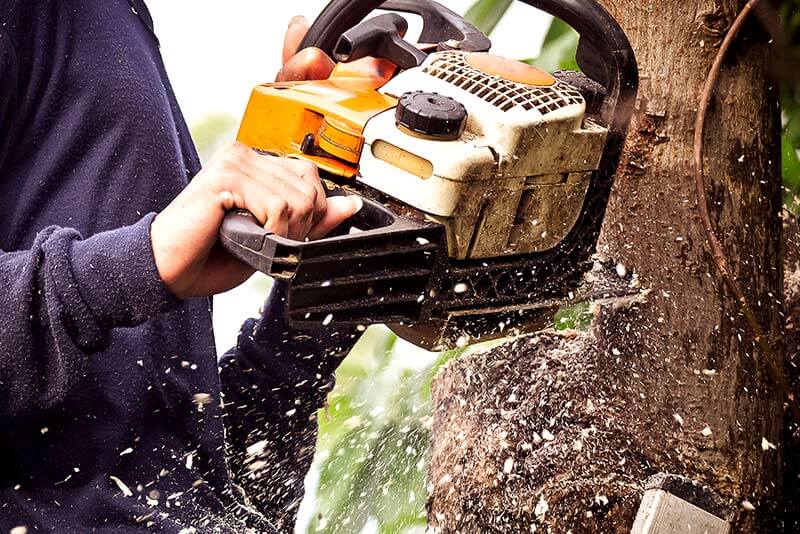Do you reside in a gated community? Or perhaps you’re contemplating relocating to one? Chances are, you’ll encounter an HOA. HOAs, short for Homeowners’ Associations, primarily exist to establish regulations that serve the community’s best interests and to enforce compliance among homeowners to adhere to these rules.
According to the HOA tree removal policy, board members are allowed to state the terms and processes for tree removal within their communities. For instance, if a tree in a common area is affecting any member’s property or is damaged and needs to be removed, the HOA is responsible for it. However, if the tree is within the boundaries of a resident’s property and is damaged due to neglect or improper care, the homeowners are responsible for the tree removal.
In this article, you will learn more about the HOA tree removal policies, tree disputes, and unenforceable rules.

What we cover
ToggleHomeowner’s Association (HOA) tree removal policies
The HOA tree removal policy aims to address all the facets of tree removal from the determination of ownership to steps to take depending on the issue. HOA tree removal policies help to establish healthy boundaries to promote peaceful co-existence between neighbors. All neighbors are expected to do their part to keep the community thriving.
Here are a few HOA tree removal policies;
1. Determination of ownership of trees
HOA policies help to determine tree ownership. When it comes to the maintenance and care of trees in a housing community, it falls to the owner of the tree. The owner of a tree is the one who owns the land on which the tree grows.
That means that any tree within your property is yours and therefore you have a responsibility to maintain and care for it. If a tree borders two properties, we use state rules to determine ownership. For e.g in California, the property on which the trunk sits is the owner.
If the trunk is on the property line, then it becomes a shared responsibility1 between the two homeowners. If the tree is located in a public or common area, the HOA is responsible for it.
2. Reasons for tree removal
HOA policies should state the reasons why you may be asked to remove a certain tree. This allows homeowners to know the rules and prevent them from happening. There are many reasons why your homeowner’s association might find it necessary to request the removal of a tree. They include;
- Hazard concerns. When trees grow too close to a building, they can damage the exterior which can be hazardous. Also, diseased trees can infect others around them.
- Safety issues. Overgrown trees with dead branches can cause serious injury if they were to fall and hit a resident.
- Potential damages. If your tree is damaging property e.g. overgrown root breaking sidewalks or overgrown branches damaging a neighbor’s fence.
- Privacy issues. If the tree is blocking a neighbor’s view, it can be considered a nuisance and you will be required to remove it.
- Lack of care and maintenance. If a homeowner refuses to undergo the proper care and maintenance required for the tree on their property, leaving the tree to become unhealthy and a safety hazard, etc.
3. Other HOA policies on tree removal
HOAs usually have already set policies on how to handle issues including tree removal. This allows for fewer disputes between homeowners and the HOA. Steps on how to handle future issues. HOA policy should clearly state the terms and the processes for removing a tree within the community.
Policies guiding aspects of tree removal such as conservation, tree planting guidelines, and maintenance should be updated regularly. The HOA can also implement a case-by-case method that allows board members to evaluate each case individually.
Informing and educating residents on policies regarding tree maintenance and removal helps settle disputes among neighbors and answer their questions. Current governing documents should use clear and precise language that is easy to understand and provides consistent and effective solutions.
Trees are community assets and how they are handled will affect property values and other important factors.
HOA tree disputes
Where there are rules and regulations, there is bound to be pushback from residents especially when they believe they are being treated unfairly. Here are a few ways to deter disputes regarding tree removal.
1. Determine ownership of the tree
Before trying to solve any dispute when it comes to tree removal, you must first determine whose tree it is. The ownership of the tree depends mainly on property boundaries. Any tree within your property boundary is yours and trees in common areas are in the care of the HOA.
Knowing who owns the tree allows for better resolution. If a tree sits on one property but its branches and roots extend into another’s property, it is still their tree and therefore their responsibility.
2. Provide reasons why the tree needs to be removed
A clear report stating why the tree should be removed. This is an essential way to resolve disputes concerning tree removal. This is because it allows the tree owners to understand why the HOA requests the tree to be removed.
Many issues like safety risks if the tree is planted too close to the home, dead or damaged trees due to neglect, pest infestation, etc. are plausible reasons why you may be asked to remove a tree by the HOA.
3. Review the existing tree removal policy for the appropriate steps
After determining the ownership of the tree and the plausible reasons why the tree should be removed, the HOA needs to handle the situation according to the association’s policies. These policies are usually communicated to the members and are a fair way to deal with the situation.
Following the HOA guidelines on how to handle tree removal can prevent long and messy disputes with residents and allow for easier processing. It also ensures a level of sameness for all residents, removing doubts of partiality.
4. Plan for future disputes
If a situation comes up and there is no policy on how to handle it, it may end up causing a messy dispute between the HOA and the resident. One way to prevent that is by revising and amending the tree removal policy to accommodate all potential issues.
This allows for easier tree removal processes as homeowners are made aware of the rules and the possible results of neglecting their trees. It serves as a discouragement to defaulting residents and a guide for the HOA on how to handle them.
Removing trees without HOA approval
Can you remove a tree without HOA approval? Well, yes. If the tree in question is situated on your property, its care and maintenance fall squarely on you. This also gives you the privilege of deciding if you want to remove it or not.
However, for trees on a neighbor’s property or in a common area, you are not allowed to remove or handle them. If any tree outside of your property is causing you any issues, you will have to direct your complaint to the person in charge.
For trees in a neighboring property, try and talk with your neighbor before sending an official complaint to the HOA. For trees in common areas, direct any complaints to the HOA as they are responsible.

Do I need HOA approval to plant a tree?
Yes, you need HOA approval before planting a tree. There are certain factors the HOA will consider before allowing you to plant a tree. They include:
1. Size of the tree when mature
There are different species and varieties of trees out there with some growing to monstrous heights upon maturity. The HOA has to determine whether or not the type of tree you want to plant will be too big for the area when mature.
Some HOAs have approved lists of trees that are allowed to be planted. Trees that grow taller than the house, trees that tower over or obscure the house, etc., are usually not allowed by HOAs.
2. Amount of maintenance
One of the jobs of HOAs is to provide homeowners with a clean and nice living environment. Although trees can improve the look of a place, they can also reduce it. Trees require proper maintenance to grow well and look good.
Some HOAs take care of the mowing, surface cleaning, and trimming. These HOAs may require homeowners to plant low-maintenance trees that make it easier for maintenance to work.
3. Possible safety or hazards caused by trees
Depending on the area you live in, certain trees may be hazardous to plant. For example in windy places, HOAs may require homeowners to plant well-known wind-resistant trees to prevent flying branches during wind storms.
This prevents the number of hazards that may be caused by trees and reduces liability on the HOA.
Some unenforceable HOA rules
1. HOAs cannot discriminate or selectively enforce rules
All laws must be applied fairly and consistently amongst residents. Any evidence of discrimination is illegal as it goes against the Fair Housing Act. Residents are not to be discriminated against based on any criteria be it race, sex, religion, political affiliation, etc.
2. They cannot enact rules without a vote
Before any new rule is put into effect, it must be brought before the community which will then vote for or against it. The association is not allowed to set the rules, only enforce them.
3. They cannot contradict the US constitution
All HOA laws, policies, and guidelines must be under the United States Constitution. Any law that goes against the US Constitution is null and void. HOAs cannot infringe upon the constitutional and human rights of their homeowners.
4. Prevent the display of the U.S. Flag
HOAs cannot ban the display of the US flag as this is a federal right that cannot be interfered with. Residents are allowed to proudly spread out the flag without any interference from the HOA. However, the size specifications can be determined by the HOA.
Do I need city approval to removal a tree?
The Home Owners Association (HOA) is your first point of contact, but if you are trying to remove an established oak tree in California, you might have trouble convincing the city to give you approval.
Every state and county has its own tree removal laws. You need to make sure it is legal to remove a tree, even if your HOA has given you the go-ahead.
- FindLaw, (2023) Property Boundaries, Lines, and Neighbors FAQ. <https://www.findlaw.com/realestate/neighbors/property-boundaries-lines-and-neighbors-faq.html> Accessed: 13-02-2024.














